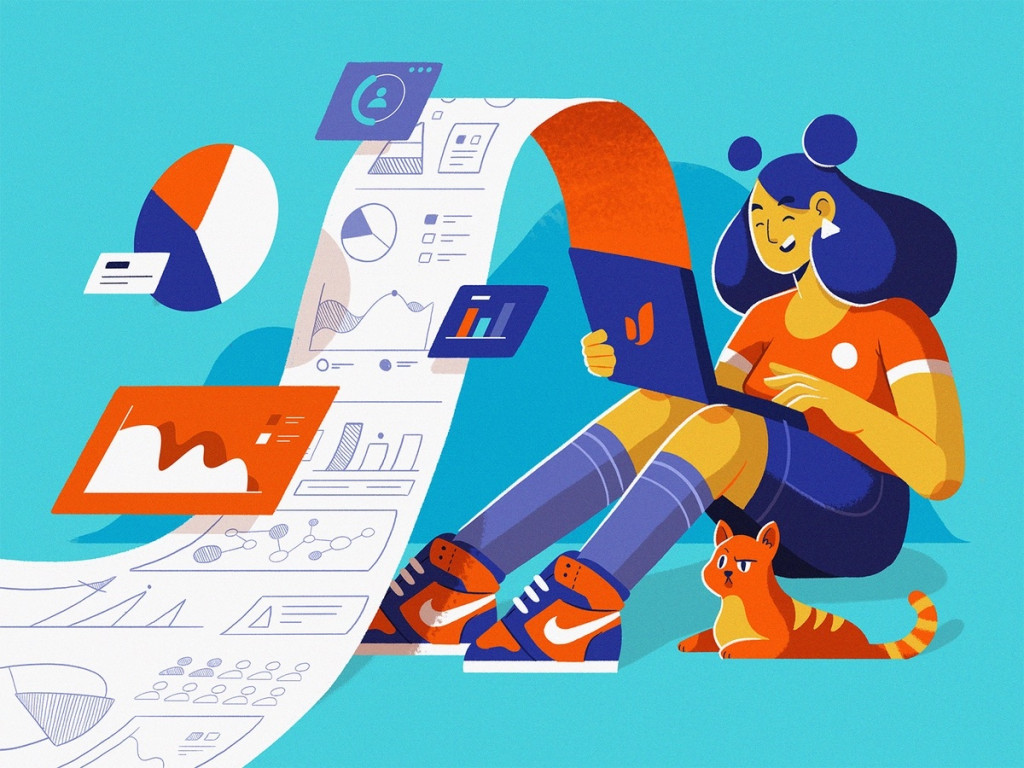Every company tries to achieve a particular goal — reach more customers, increase sales, or provide more value to its clients. Although most companies pursue practically similar objectives, the way of achieving them might be different. But which one could be “the one” for your particular business with our website design outsourcing?
One of the most innovative and effective frameworks nowadays is called Jobs To Be Done. It’s really useful to implement Jobs To Be Done UX design, project management, or any other corporate task. If you have doubts about implementing this approach in your company, we’re here to help you out. Read this article to answer all your questions regarding this ui ux company methodology right away!

What is Jobs To Be Done (JTBD)?
Jobs To Be Done (JTBD) is an approach that helps teams find the key focus points, solve ideation issues, and create a shared vision for each stage of work and product development. This is an innovative, user-focused mindset. It’s based on the opinion that a company should focus on the “job” a customer wants to complete.
The JTBD philosophy states that you’ll bring innovation if you meet a customer’s need that’s not yet been satisfied by another existing product.
The Jobs To Be Done methodology is based on several key principles:
- Customers “hire” a product or service to fulfill their needs — and, if there’s a better alternative on the market, they “fire” your solution and switch to a new solution. This idea should be useful while working on the innovative part of your product and focus on the customers’ final needs;
- Finding the job that your solution has been “hired” for — and thinking of the ways to either improve your product or maintain its high level of quality as the time goes by to make sure it’s stable and aligns with your business goals perfectly;
- Jobs aren’t just functional but also emotional and social — this aspect is important in defining the behavioral patterns of your customers and improving the overall experience. Define what your product helps achieve or avoid, what it feels like, and how it can be perceived. It will help create more value and improve your product on various levels.
So, the Jobs To Be Done format is a perfect option for the companies that need to bring more innovation to their products/services and implement a more user-centered mindset. It’s based on the job your solution can do and making sure it will be the most suitable one as time goes by.
Jobs-to-be-done (JTBD) Framework
If you consider bringing this approach into your company, do some research and develop an action plan that would help you implement this step-by-step. There are numerous Job To Be Done framework examples, but most are pretty similar in structure.
Here’s a detailed guide on doing this properly to facilitate this task for you.
Step 1. Define what Jobs Your Customer Needs to Complete
It’s an important stage in defining what your product or service lacks. Take all the points into consideration and think differently. A quick tip: try thinking about the job that hasn’t been completed by anyone yet. This is the innovation your solution may lack and what you should add before the launch.
To define what kind of innovation your product/service lacks, conduct some research. Since a JTBD approach is user-centered, gather focus groups and do in-depth interviews. Feedback from your target audience is what you’ll need to provide the perfect solution. It’s also suitable for prioritization and faster problem-solving.
Step 2. Categorize the Jobs You Need to be Done
The jobs in this framework have various nuances and can be divided into such key categories:
- Main jobs are the essential tasks a customer needs to complete (sunglasses protect your eyes from the UV impact)
- Related jobs are extra tasks a user wants to accomplish; they’re not essential but create an added value to your solution (look more stylish and add some final touch-ups to your outfit)
As you’ve read above, these jobs have functional and emotional aspects. The functional ones are related to the practical usage of your solutions (protecting your eyes and making sunny days more bearable). In turn, emotional aspects help users generate specific emotions and feelings towards your product (making others jealous of your new glasses).
If you dig deeper, you’ll find that one can also view emotional aspects from personal and social paradigms. A personal paradigm is how users see your product’s value (paying extra for more comfort and beauty). A social one is how people think they are perceived while using your solution (now you look like a model from the magazine cover).
It’s essential to define each of these elements properly to make a universal product that would fulfill the needs of more customers. And, eventually, make them hire your product instead of someone else’s.
Step 3. Find Your Competition
Sure, you’ve done some competitor analysis previously. But have you considered looking for competitors from other product ranges? Did you think of the fact that a completely different type of solution can do the job your product is supposed to fulfill?
At this step, broaden your horizons to see what potential competition is there. It will help you think out of the box and drive more innovative ideas you could implement in the future and greatly improve your product.
Step 4. Work on the Job Statements
While working within the JTBD framework, you develop job statements, but not in the way you might think. While creating them, don’t attach a specific job to a certain kind of product. The key player here is the job. The product comes next. Product is what is yet to be created, with as many innovative features and add-ons as possible.
There’s a simple formula you can follow to create these job statements: Action + Object + Context. For example, in the case of sunglasses:
- Action: support / maintain
- Object: my eyesight and style
- Context: with no extra effort
Step 5. Think of the Opportunities and Rank Them
Prioritization is important while applying the Jobs To Be Done approach in your work. There’s a special scale that helps you understand what job to put in the front row. It shows the importance of a job to customers and how much they’re satisfied with the product they’re using now.
There are three possible outcomes for a given JTBD:
- Well-served: a job is important, and the solutions are good
- Under-served: a job is important, and the solutions aren’t satisfying
- Over-served: a job is unimportant, the products are good
Respectively, you’ll need to switch to providing a solution to related jobs, make the existing one better, and re-think its concept.
Step 6. Define the Possible Outcome Expectations
These advantages and flaws aren’t tied to a specific feature. Within the JTBD framework, there are four main types of outcome expectations: outcomes that providers want to achieve or avoid and the ones customers want to achieve or avoid.
Define, visualize, and make necessary assumptions. This helps a lot with action planning and problem-solving as you can clearly see what possible issues will be there for both you and your customers.
Step 7. Work on Desired Outcome Statements
This is what shows you how customers perceive your solution’s value. Just like the job statements, they’re not attached to a particular solution. Instead, they help managers and designers realize what users want to see the most in what you offer.
How do you formulate such statements? It goes like this: Improvement + Measure + Object of control.
Once you’ve gone through all the steps — get back to work. You’ve got a rockstar solution to create!
Benefits of Jobs-to-be-done Methodology
Once you know how the Jobs To Be Done approach works, it’s time to discuss its advantages. Once you start working under such a system, you’ll see it makes a lot of sense. So why consider JTBD?
It’s a Powerful Innovation Driver
Just like we discussed earlier, JTBD is a great tool to encourage the creation of new solutions. Since the statements created with the help of this approach aren’t related to a specific solution, it helps you look at it from different angles. As a result, you start thinking about alternative options that might be even better than the original idea.
User-centered Approach
One of the main perks of this methodology is that users and their needs are put in the first place. However, it only works when customers know for sure what they want. So, it requires researching desired and non-desired outcomes for users before actually getting to work.
It Keeps You from Creating Something Useless
You may create something really cool with a ton of high-end features, but what would be their point if they’re not in demand? Applying the JTBD methodology will prevent you from that risk and save you loads of time working on something nobody needs.
Jobs-To-Be-Done vs. User Personas
One last thing left to discuss is this long-lasting battle — Jobs To Be Done vs User Stories. Let’s have a quick overview of each one of these approaches.
Basically, a Jobs To Be Done persona or a Job Story is a more advanced version of User Stories that focuses on allocating responsibilities in product design. The latter comes from User Personas that don’t necessarily reflect the actual state of things, while Job Stories are based on the real needs of their real customers.
So practically, User Stories are just someone’s imagination based on a range of assumptions with no stated facts.
Despite this, both types are quite powerful tools in product design. The thing is that you should know when to use each particular approach. For example, if you see that your product users differhttps://fireart.studio/blog/5-fundamental-principles-of-ux-design-psychology/ in many ways, it’s better to apply User Stories and vice versa.
When you see that users are extremely different, User Personas might help you better understand what user groups and what kinds of needs prevail among your potential and real users.
To understand your customers and define their needs more precisely, try combining both approaches.
Adopting a customer centric model within this framework can significantly enhance the effectiveness of both Job Stories and User Stories, as it ensures a deeper understanding of customer motivations and behaviors.
Still, what makes Job Stories better than the User ones is that it’s focused on motivation to reach the necessary outcome and precise facts. As a result, it helps save time defining user needs, and you’ll understand better if you’re going in the right way.
Final Words
The JTBD framework is quite a helpful and effective methodology many companies can implement in their product development and UX design processes. It’s a user-centric approach that allows you to focus on the desired outcomes rather than features. Thus, it enables us to think of various solutions and encourages innovation while working on them.
We at Fireart Studio know how your company could make use of this framework and how to avoid UX design issues while working with the JTBD mindset. So if you’re eager to learn more about that, feel free to reach out. Or hire ux developers. We will gladly help you!





















